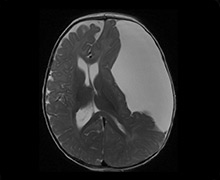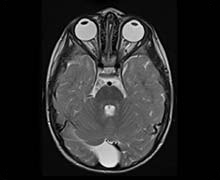Arachnoid Cyst
-
Schedule an appointment with the Neurosciences Center
If this is a medical emergency, call 911.
- If you would like an appointment, ask your child’s primary care provider for a referral.
- If you have a referral, call 206-987-2016 or 844-935-3467 (toll-free).
- How to schedule.
If you have any questions, please contact us at 206-987-2016 or 844-935-3467 (toll-free).
-
Find a doctor
- Meet the Neurosciences team.
-
Locations
- Seattle Children’s hospital campus: 206-987-2016 or 844-935-3467 (toll-free)
- Bellevue Clinic and Surgery Center: 206-987-2016 or 844-935-3467 (toll-free)
- Everett: 425-783-6200
- Federal Way: 206-987-2016 or 844-935-3467 (toll-free)
- Olympia: 206-987-2016 or 844-935-3467 (toll-free)
- Tri-Cities: 206-987-2016 or 844-935-3467 (toll-free)
- Wenatchee: 206-987-2016 or 844-935-3467 (toll-free)
-
Refer a patient
- Urgent consultations (providers only): call 206-987-7777 or 877-985-4637 (toll free).
- If you are a provider, fax a New Appointment Request Form (NARF) (PDF) (DOC) to 206-985-3121 or 866-985-3121 (toll-free).
- Send the NARF, chart notes and any relevant documentation to 206-985-3121 or 866-985-3121 (toll-free).
What is an arachnoid cyst?
An arachnoid (pronounced ah-RACK-noid) cyst is a sac filled with fluid inside the head or spine. Arachnoid cysts develop between the brain or spinal cord and a membrane that covers the brain and spinal cord, called the arachnoid membrane. The fluid in the cyst often is cerebrospinal fluid (CSF), a clear liquid that protects and nourishes the brain and spinal cord.
Arachnoid cysts are more common inside the head than around the spinal cord. In a child’s head, an arachnoid cyst can be between the brain and the skull or inside the brain. Arachnoid cysts in the brain form in open spaces called ventricles that normally contain CSF.
Arachnoid cysts are found in many parts of the brain. Most are in the middle or back of the brain.
Arachnoid Cyst in Children
In the United States, about 3 children in every 100 have an arachnoid cyst. Most of these cysts never cause any problems or symptoms or need any treatment. Doctors often find arachnoid cysts when they examine a child for another reason, such as after a head injury.
If your child has a cyst that does not cause symptoms, the doctor may just watch the cyst to make sure it does not change size. If the cyst causes symptoms, doctors may remove it surgically. Most children with arachnoid cysts do not need surgery.
Arachnoid cysts are often present when a child is born (congenital). Arachnoid cysts that are present at birth are called primary arachnoid cysts.
Arachnoid Cyst at Seattle Children’s
Our medical team has cared for many children with arachnoid cysts. We have a great deal of experience diagnosing arachnoid cysts and deciding whether a cyst needs surgery. Our neurosurgeons and radiologists use MRI (magnetic resonance imaging) to tell arachnoid cysts apart from other types of problems, like tumors. When needed, our neurosurgeons use the latest technology, equipment and surgery techniques to remove arachnoid cysts.
Symptoms of Arachnoid Cyst
Most people with arachnoid cysts do not have symptoms. Doctors often find these cysts when a child with no symptoms has a CT (computed tomography) scan or a MRI (magnetic resonance imaging) of the brain for other reasons. If your child’s cyst does not cause symptoms, your child probably does not need treatment. The doctor may watch the cyst to make sure it does not change size.
Rarely, an arachnoid cyst can cause problems that lead to symptoms. The symptoms may relate to how big the cyst is and where it is located. For example, it may block the flow of cerebrospinal fluid (CSF). Blocked CSF leads to a condition called hydrocephalus, which increases pressure inside the skull. If an arachnoid cyst bleeds, it can cause sudden, severe head pain.
If your child’s cyst causes symptoms, doctors may recommend surgery to remove it. But most children with arachnoid cysts do not need surgery.
Diagnosing Arachnoid Cyst
 This arachnoid cyst (clear area on the right) is large and pushing on the brain. Surgeons drained the cyst.
This arachnoid cyst (clear area on the right) is large and pushing on the brain. Surgeons drained the cyst. This is a smaller arachnoid cyst in the back of the brain (posterior fossa). There is no sign of bleeding, hydrocephalus, or pressure on the brain. Surgery is not needed for cysts like this.
This is a smaller arachnoid cyst in the back of the brain (posterior fossa). There is no sign of bleeding, hydrocephalus, or pressure on the brain. Surgery is not needed for cysts like this.
Doctors often find arachnoid cysts when they examine a child for another reason, such as after a head injury. An arachnoid cyst may show up when a child has a CT scan or an MRI of the brain.
If your child’s doctor finds an arachnoid cyst, your child will come to the Neurosurgery Clinic for a complete evaluation. Your child will need a brain MRI with contrast. This imaging test helps doctors tell an arachnoid cyst apart from other types of problems, like tumors.
It can be very stressful to learn that your child may have a cyst or condition that affects the brain or spinal cord. We will carefully review your child’s scans and any symptoms your child has to give you a clear diagnosis. Our team has a great deal of experience diagnosing arachnoid cysts, telling them apart from other problems and deciding whether they need surgery.
Most children do not need surgery if they have an arachnoid cyst without symptoms. If your child does not have symptoms, your child will need MRIs to make sure the cyst doesn’t grow and start causing symptoms. Your child’s team will recommend a schedule for these MRIs.
Arachnoid Cyst Treatment Options
An arachnoid cyst rarely causes symptoms. If your child has a cyst without symptoms, the doctor may just watch the cyst to make sure it does not change size.
If an arachnoid cyst is causing symptoms, your child may need surgery to remove it. Depending on your child’s needs, the neurosurgeon will recommend 1 of 2 surgeries to remove the cyst.
-
Open the cyst (fenestration)
Your child’s neurosurgeon makes a small cut (incision) near the arachnoid cyst and takes out a small piece of the skull bone. Then the neurosurgeon puts a small, flexible tube called an endoscope through the incision. The endoscope has a tiny light and a camera that allows the neurosurgeon to see the cyst. The neurosurgeon uses the endoscope to make a hole in the cyst and open it up (fenestration).
Once the arachnoid cyst has been opened, the fluid inside drains out of the cyst into other areas of the brain that contain cerebrospinal fluid (CSF). Your child’s body reabsorbs the fluid from the cyst.
-
Put a shunt into the cyst
A shunt is a tiny tube (catheter) that drains CSF from one place in the body to another. Learn more about shunts.
After your child’s neurosurgeon makes a small cut near the arachnoid cyst, they place the shunt into it. The shunt drains the fluid from the cyst into another part of your child’s body, like the belly (abdomen). Once the fluid is in the belly, your child’s body reabsorbs it.
Contact Us
If you would like an appointment, ask your child’s primary care provider for a referral. If you have a referral, call 206-987-2016 to make an appointment.
Providers, see how to refer a patient.
If you have questions, contact us at 206-987-2016 or 844-935-3467 (toll free).
-
Schedule an appointment with the Neurosciences Center
If this is a medical emergency, call 911.
- If you would like an appointment, ask your child’s primary care provider for a referral.
- If you have a referral, call 206-987-2016 or 844-935-3467 (toll-free).
- How to schedule.
If you have any questions, please contact us at 206-987-2016 or 844-935-3467 (toll-free).
-
Find a doctor
- Meet the Neurosciences team.
-
Locations
- Seattle Children’s hospital campus: 206-987-2016 or 844-935-3467 (toll-free)
- Bellevue Clinic and Surgery Center: 206-987-2016 or 844-935-3467 (toll-free)
- Everett: 425-783-6200
- Federal Way: 206-987-2016 or 844-935-3467 (toll-free)
- Olympia: 206-987-2016 or 844-935-3467 (toll-free)
- Tri-Cities: 206-987-2016 or 844-935-3467 (toll-free)
- Wenatchee: 206-987-2016 or 844-935-3467 (toll-free)
-
Refer a patient
- Urgent consultations (providers only): call 206-987-7777 or 877-985-4637 (toll free).
- If you are a provider, fax a New Appointment Request Form (NARF) (PDF) (DOC) to 206-985-3121 or 866-985-3121 (toll-free).
- Send the NARF, chart notes and any relevant documentation to 206-985-3121 or 866-985-3121 (toll-free).